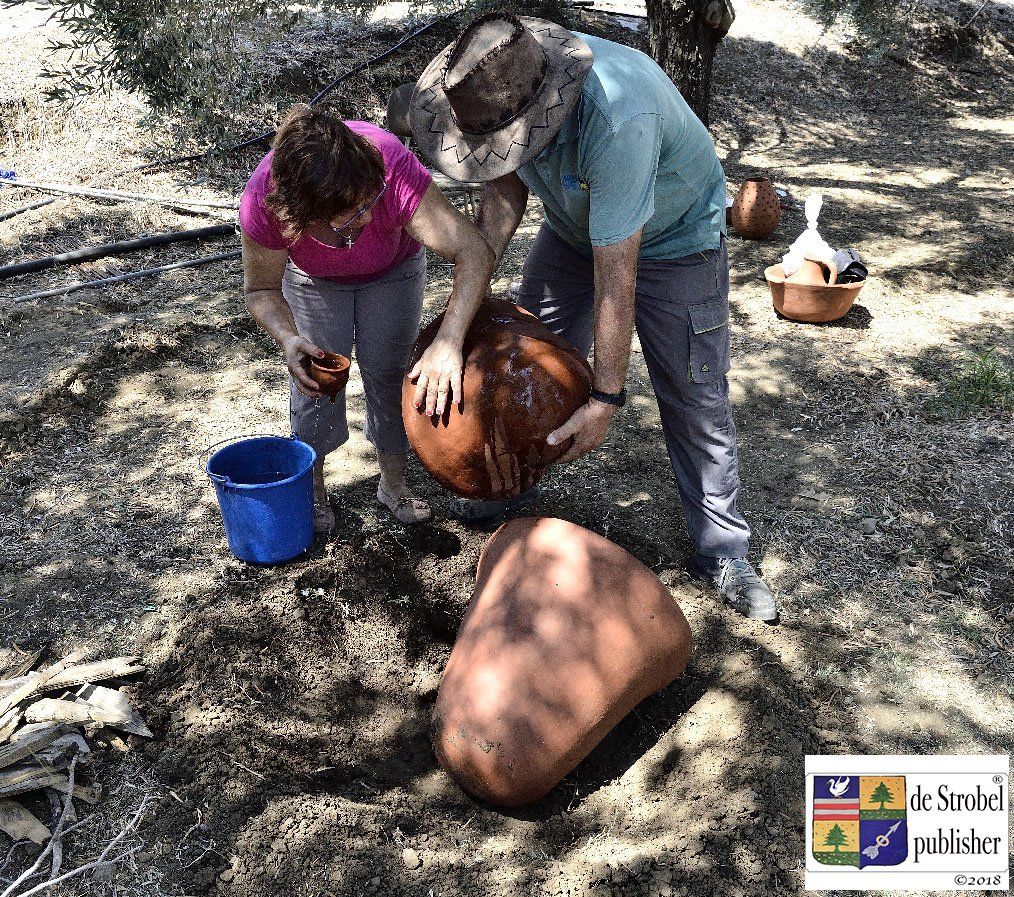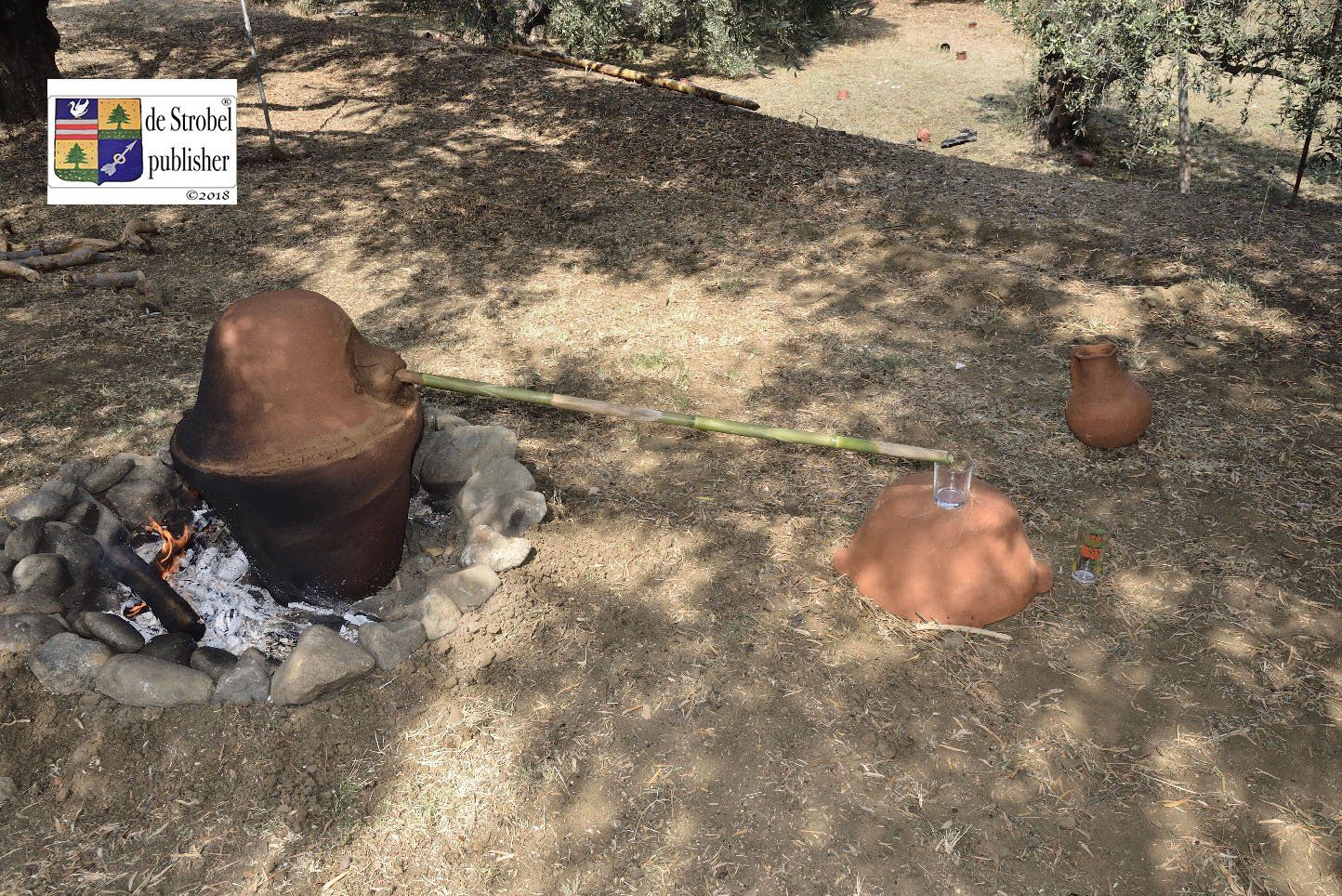Tepe Gawra - Iraq 5° millennium BC apparatus distillation experiment
Perfumery Theme Park 25 August 2018 Korakou village Cyprus
Notes on Tepe Gawra apparatus experiment
The experiment made with replicas of the Tepe Gawra famous channel pot and other pots found in the same site to demonstrate that the apparatus was used to distil.
The case concerns the appearance of a new typology of pottery which since its discovery was supposed to be an apparatus to distil. It belongs to the end of the fifth millennium BC and was found in five different sites in Northern east Mesopotamia. It concerns a peculiar shape of a large, deep pot, roughly conical with rounded base which has a double rim forming an inside channel with a series of holes in the bottom, presuming to collect back liquids from an extra top device.
Since the beginning of its discovery it was supposed to be part of an apparatus to distil. Twelve specimens of this vase, four complete and eight fragments have been found at Tepe Gawra in Iraq, a small village of about one hectare, along the Tigris valley hosting a community of 150-200 people from the 7th millennium to the 2nd millennium BC, near the actual village of Fadiliyah.
The name of Tepe Gawra comes from the Kurdish words meaning “great mound, it is geographically positioned 24 km NE of Mosul, and was investigated during the British occupation of the region in 1927 by Ephraim A. Speiser. In the last fifty years other sites around Tepe Gawra in the Tigris valley have been investigated and more specimens and fragments of vases fitting to the same typology have been found at Tell Qalinj Agha (Erbil), Tell Brak, Leilan Tepe and Tell Khirbat al-Fakhar Hamoukar and Arslan Tepe (Malatya) in Turkey.
All seem to belong to the same chronology spanning between the 4200 to 3800 BC, corresponding to the IX-XII levels of Tepe Gawra, the CH XIII of Tell Brak and LC1-2 (Late Ubaid 1-2) of Khirbat al-Fakhar Hamoukar, testifying that the pot is far to be an isolated phenomenon at Tepe Gawra, as it is generally reported in publications of the history of perfumes.
Comparing the examples found in five sites at different levels, archaeologist Khaled Abu Jayyab observes an evolution of the type, as in the earlier examples the inner rim is roughly the same height as the outer rim, while in later examples the outer rim is three times the height of the inner rim.
This means that the shape was intentionally modified to improve its efficiency.
Martin Levey (Pennsylvania State University), who in 1950 assembled some vases of Tepe Gawra from the fragments, recognised their function, making comparison with description of similar objects reported in Akkadian texts of the mid- 2nd millennium BC and in Muslim texts of Arab Alchemists al Razi (Abu Bakr Mohammad ibn Zakariya al Razi 864-930) and Jabir (Abu Musa Jabir ibn Hayyan al azdi 721-815), suggesting a millenary management and surviving of the ancient Mesopotamia technology, in Arab Alchemy. In his research, the scholar tends to demonstrate the passage and historical continuity of the art of Mesopotamian perfume into the Arab world, returning to the issue in several papers. His investigation started from the translation of some Accadian tablets which report that Tapputi-Belate Kallim, Twelfth-priestess of Muhur ilani, Limmu of Qatnu-Gardu, was the perfumer of the king, expert in making fragrances with flowers (rose?), oil and Calamus according to the technique of distillation. In his book "Early Arabic Pharmacology” Levey includes some recipes and the translation of the passage mentioning the distillation procedure.
The twelve pots of Tepe Gawra belong to a very precise Late Ubaid typology. All have a deep body with rounded conical bottom, which suggests the employ of a stand or contrivance of large dimensions for use on the fire. In practical terms, the vessel has a 50cm diameter mouth (medium sized) with a channel ring 8-cm thick and 10/12 deep, corresponding to a capacity of 37/40 litres for the pot and 2 litres for the gutter, as it is well visible in (replica of the Chemicals Museum at La Sapienza of Rome). Considering that the lid is an interpretation made to give a complete appearance of the device, the size of the canal around the jar occupies a large percentage of the total height of the vase, being a sufficient room where it was possible to locate berries, resins, flowers, or crushed parts of plants to make scented waters.
Considering the importance given by Needham to the presence and position of the strainer in the Chinese apparatus, and the surviving of this component in modern and primitive devices producing alcoholic beverages and perfumes, I searched in the inventory of the finds of Tepe Gawra recordings of filter pots, or clay movable strainers, finding items of different shape in five diverse levels.
The most interesting is n. 360, which has perfect dimensions (h. 33,6, d. 22,2) to be inserted inside the channel pots and holds a quantity of organic material. The shape is that of an elongated oval strainer flask with a short-rounded neck and walls completely pierced. A second similar specimen was found in level X, but not illustrated because it is too fragmentary.
It suggests a specific alternative use of the apparatus as for simple Hydro-distillation, as for the steam distillation according with the different typologies of plants available in the region. Ann Harman (2015) in her book Harvest to Hydrosol describes clearly the difference between hydro-distillation with plant material in water, steam distillation with plant material above water, wet steam distillation with plant material on screen above water, and hydro/steam combination with plant material both in the water and above water. What is interesting about the drawings she published to explain the differences, is the presence in one of a columnar element superimposed to the pot, separated by filter elements, holding the plants to be processed that suggests the correct use of the elongated cylindrical or oval flask strainers found at Tepe Gawra.
The Tepe Gawra apparatus, mentioned in almost all the books regarding the history of perfume, has been previously reconstructed (Rysanek & Václavû) with an imaginary cover with two unlikely ears/handles, which have no comparison with any of the clay ceramics found on the site. With the pottery repertoire published by Ephraim A. Speiser (1935), James Arthur Tobler and Mitchell S. Rothman, as well as other published material, it is possible to speculate different solutions concerning the top of the channel pots are from being sublimation devices.
Among the repertoire of Tepe Gawra a spouted pot was found in level IX (spout fragmentary, preserved only the half: Tobler inv. N° 411, Pl. CXLVII (Rothman n° 2233; 3-137 33-3-63 level IX, red brown ware 9K 80, H. 30,3cm, rim D. 38 cm), which may represent an interesting possibility, not only because it is spouted, but for the intriguing case it has the same shape and mouth diameter of some channel pots from Tepe Gawra and Tell Hammoukar. Moreover, as the max. diameter of T.G. n. 2233 is 38cm it is possible to use it as a head on three pots from Tepe Gawra with the inside rim of 37 cm, and on other fragmentary specimens which seem to have the same dimension. In the case of Tepe Gawra n. 406 (inside rim 37 cm) under Tepe Gawra n.2233 we obtain an interesting complete apparatus which take advantage both of a channel rim to recover the dripping coming down from the walls (enriching the result), and a side spout to collect the condensation. A combination more realistic than the graphic reconstruction proposed by Rysanek & Václavû . The pots together form a normal still apparatus, giving reason for the channel/strainer that holds inside the plants to be distilled and to the spouted pot as top to collect the water distilled.
Maria Rosaria Belgiorno
Today, the first cycle of experimental trials at the Cyprus Perfumery Theme Park Museum is concluded with the Chalcolithic apparatuses of Tepe Gawra of 4200, 3700, and 3500 BC, using Pine tree and Rosemary leaves. This last is the most recent (3500 BC), corresponding to No. 2227 of the Penn Museum and No. 2838 of the Baghdad Museum, which distilled for 5 hours. Archaeometry analyses of the scented produced water are in progress. It is our intention to replicate the experiments with fermented hydromel or barley to verify whether it was possible to produce alcoholic beverages with the same apparatuses and accessories
Notes of Teratsoudhia Kouklia (Cyprus) apparatus experiment
Notes of Spišský Stvrtok Slovakia apparatus experiment
Christmas trial of Experimental Archaeology at the Perfume Theme Park Museum of Cyprus, with the replica of the second channel rimmed and spouted jar of 1500 BC, found 2700 km far from Cyprus Teratsoudhia.
The case concerns an apparatus found in Spišský Stvrtok Slovakia, a Bronze age fortified village of 1500 BC in the North East Carpathians completely excavated in the ’30’s and published in 1978 by J. Vladàr through a controversial comparison with Mycenae.In 1989, J. Ryšánek & V. Václavů suggested the rimmed spouted jar was a device for distillation working with a simple bowl positioned upside down, inside of which the vapour condenses in liquid running down in the channel rim to be collected outside from the beaked spout bent over a container.
Our replica was positioned in the middle of an earth built with basalt pebbles with the fire around and a pot under the spout. The liquid came out after one hour, but, for a better understanding of its functionality we substituted the clay cover with a glass one, which allowed us to observe the formation of condensation and the collection of liquid in the channel and in the spout. The full success of the experiment confirms that the Spišský Stvrtok jar is a distiller, suggesting a long story of survival and diffusion of a technology invented in Mesopotamia at the end of the 5th millennium BC.




















